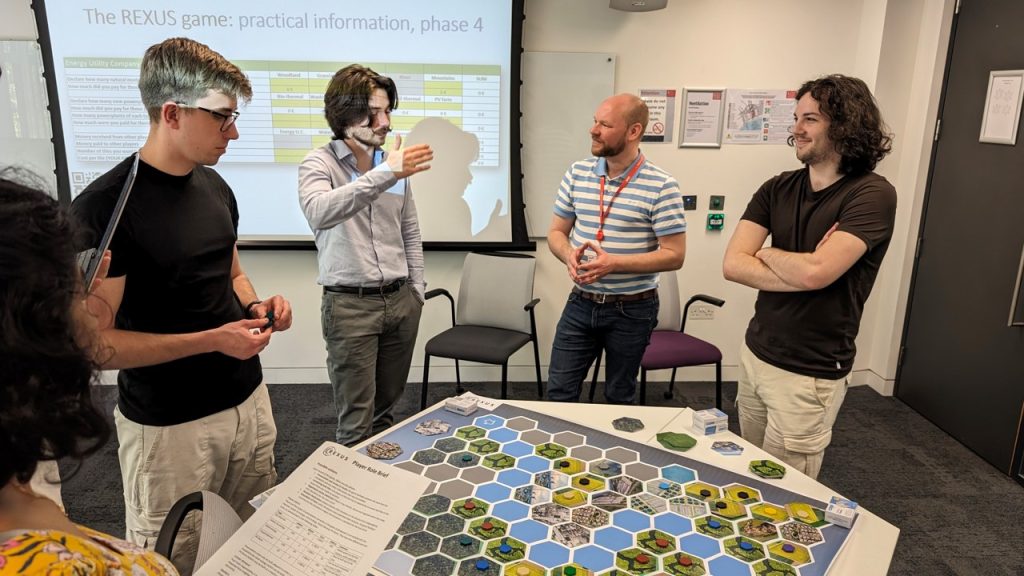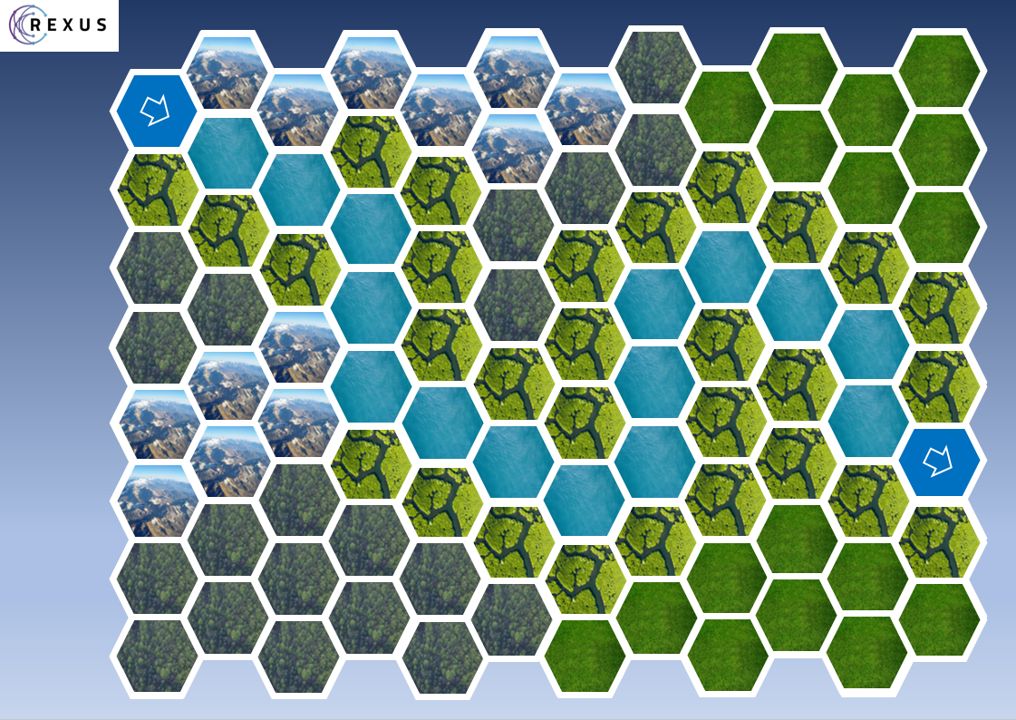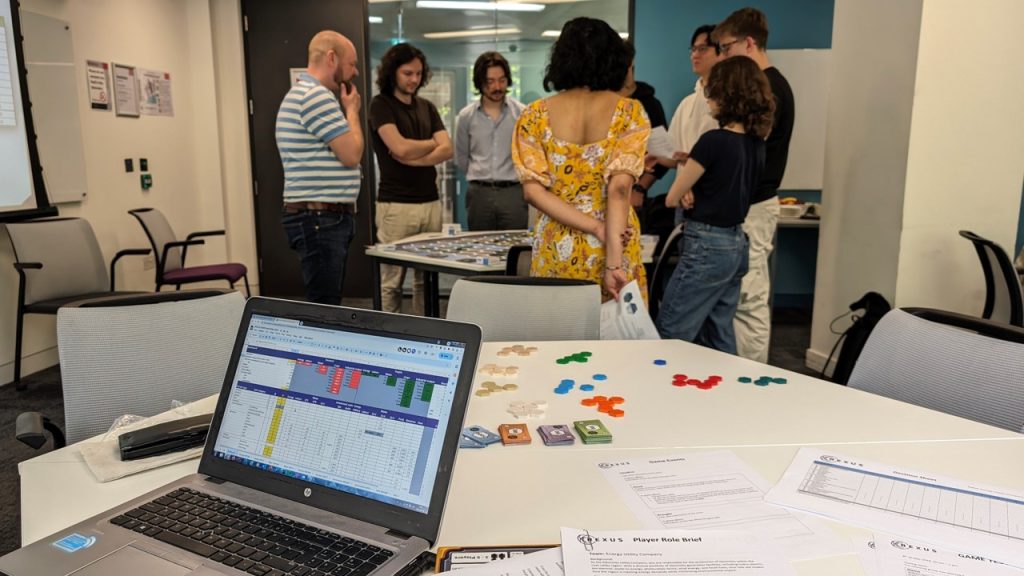The REXUS Serious Game: A Tool for Experiencing Water-Food-Energy Nexus collaboration dynamics
The REXUS Serious Game is an innovative educational and decision-making tool designed to explore the complexities of managing interconnected resources—land, water, and energy—within the Water-Food-Energy Nexus. It was developed to encourage stakeholders to engage in dialogue and collaboration, providing an interactive environment where they can simulate real-world challenges and trade-offs in sustainable development.
Objectives and Target Audience
The game is primarily aimed at a diverse group of stakeholders, including policymakers, utility companies, agricultural associations, NGOs, and academic institutions. Its main objective is to offer a structured way for participants to examine the implications of their decisions on sustainable resource management. By simulating different scenarios, the game illustrates how decisions in one sector (e.g., water usage) can have cascading effects on other sectors, such as energy production and food security, , influencing the future course of the system’s development. Playing the game, it soon becomes obvious that collaboration across sectors is necessary in order to reach a mutually beneficial outcome.
Game Dynamics
Set in a fictional river valley, the REXUS Serious Game revolves around the interactions between various sectors, all of which play crucial roles in the region’s sustainable development. Players assume the roles of different stakeholders, each with specific responsibilities and objectives:
- Electricity Utility Companies manage energy production from a range of sources, including renewable options such as wind and solar, as well as fossil-based power plants.
- Water Utility Companies oversee water distribution for residential, industrial, and agricultural use, while also managing risks such as water shortages and flooding.
- Farmers Associations focus on optimizing agricultural output by balancing water, land, and energy use in their farming practices.
- Government Entities regulate land ownership and development, introduce policies, and guide long-term regional planning.
- NGOs aim to protect and restore natural ecosystems, pushing for sustainable policies and practices that prioritize environmental conservation.
The game is structured around system dynamics, meaning that each decision made by players affects the overall system. The model behind the game takes into account various key performance indicators (KPIs)—such as resource availability, economic growth, and environmental health—which fluctuate based on player actions. Players must balance their individual objectives with the broader goal of steering the region toward sustainable resource management.

Key Elements of the Game
Interactive Board: The game board represents the fictional river valley, divided into 96 terrain tiles that cover rivers, wetlands, forests, and mountains, as well as developed areas such as settlements, industries, and farmlands. This geographic diversity allows for a detailed exploration of the region’s resources and constraints.
Decision-Making Process: Each round of the game simulates a passage of time and includes several phases:
- Negotiation Phase: Players discuss their goals and strategies, which often involve trade-offs between resource exploitation and conservation.
- Decision Phase: Teams make decisions on how to manage their resources (e.g., converting pristine nature into agricultural land, building infrastructure, or protecting natural habitats). These decisions are entered into the game’s computer model, which calculates the impact on the region’s KPIs.
- Feedback and Simulation: The outcomes of these decisions are simulated, and players are provided with updated KPIs and feedback on how their actions have affected both their own performance and the region as a whole.

- System Complexity: The game mirrors real-world challenges by introducing feedback loops and external events that can dramatically alter the course of play. For example, climate-related events, such as floods or droughts, may be announced by the game facilitator, adding additional complexity to decision-making. Players must navigate these challenges while managing the direct and indirect effects of their own actions.
- Conflict and Cooperation: One of the key learning points of the game is how conflicting goals among stakeholders can create tension. For instance, a decision by the water utility to prioritize irrigation could conflict with the energy company’s need for water to cool power plants. Similarly, government policies promoting economic growth may clash with NGO efforts to conserve natural areas. These interactions simulate the real-world conflicts that often arise in resource management.

Scientific and Educational Value
The REXUS Serious Game provides a valuable opportunity to engage with the practical implications of the Water-Food-Energy Nexus. Its design encourages players to think critically about the interdependencies within socio-ecological systems, illustrating how resource management requires both technical expertise and collaborative governance.
Through simulation, the game highlights:
- The importance of systemic thinking in addressing the global challenges of sustainable development.
- The role of stakeholder engagement in crafting policies that balance competing interests.
- The trade-offs inherent in resource management, as players must make choices that benefit their own objectives while considering the broader implications for the region’s sustainability.
By allowing participants to experiment with different scenarios, the REXUS Serious Game serves as a powerful tool for education and capacity building. It is particularly suited for use in academic settings, policy workshops, and stakeholder meetings, where it can facilitate a deeper understanding of how integrated resource management can support sustainable futures.
